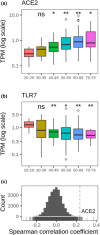COVID-19 is an emergent disease of aging
- PMID: 33006233
- PMCID: PMC7576244
- DOI: 10.1111/acel.13230
COVID-19 is an emergent disease of aging
Abstract
COVID-19 is an ongoing pandemic caused by the SARS-CoV-2 coronavirus that poses one of the greatest challenges to public health in recent years. SARS-CoV-2 is known to preferentially target older subjects and those with pre-existing conditions, but the reason for this age dependence is unclear. Here, we found that the case fatality rate for COVID-19 grows exponentially with age in all countries tested, with the doubling time approaching that of all-cause human mortality. In addition, men and those with multiple age-related diseases are characterized by increased mortality. Moreover, similar mortality patterns were found for all-cause pneumonia. We further report that the gene expression of ACE2, the SARS-CoV-2 receptor, grows in the lung with age, except for subjects on a ventilator. Together, our findings establish COVID-19 as an emergent disease of aging, and age and age-related diseases as its major risk factors. In turn, this suggests that COVID-19, and deadly respiratory diseases in general, may be targeted, in addition to antiviral approaches, by approaches that target the aging process.
Keywords: COVID-19; age-related diseases; gene expression; lifespan; pneumonia; viral infection.
© 2020 The Authors. Aging Cell published by Anatomical Society and John Wiley & Sons Ltd.
Conflict of interest statement
POF is a shareholder of Gero, and POF and AAZ are Gero employees.
Figures




References
-
- Cai, G. (2020). Bulk and single‐cell transcriptomics identify tobacco‐use disparity in lung gene expression of ACE2, the receptor of 2019‐nCov. MedRxiv. 10.1101/2020.02.05.20020107 - DOI
-
- CDC (2020). Retrieved July 21, 2020, from https://www.cdc.gov/nchs/nvss/vsrr/COVID19/index.htm
Publication types
MeSH terms
Substances
Grants and funding
LinkOut - more resources
Full Text Sources
Other Literature Sources
Medical
Miscellaneous

